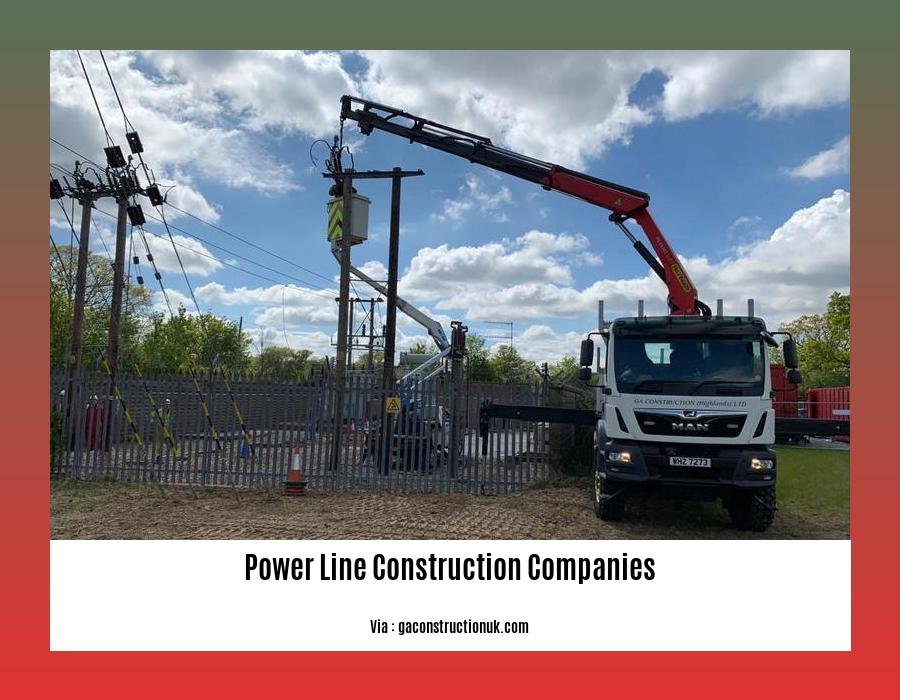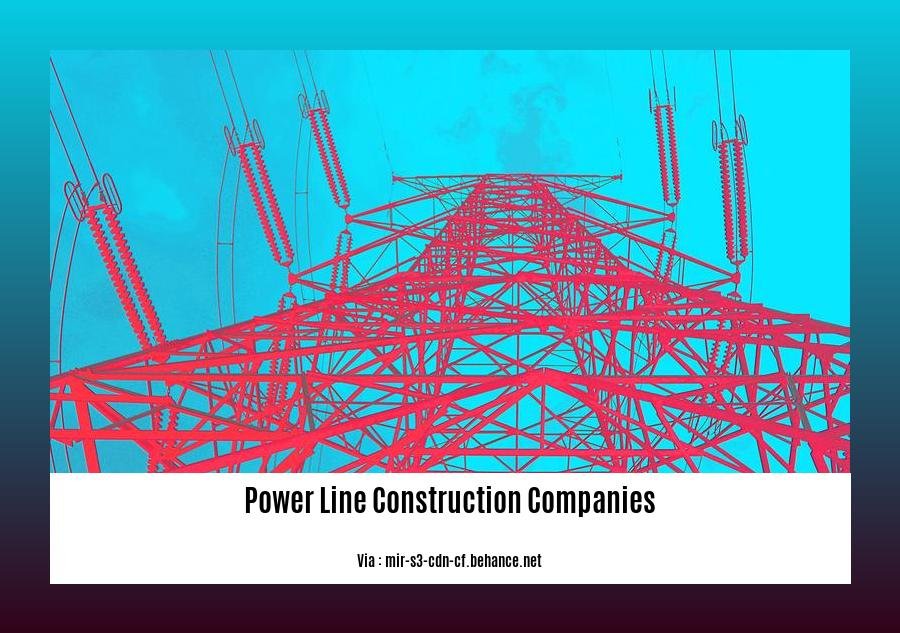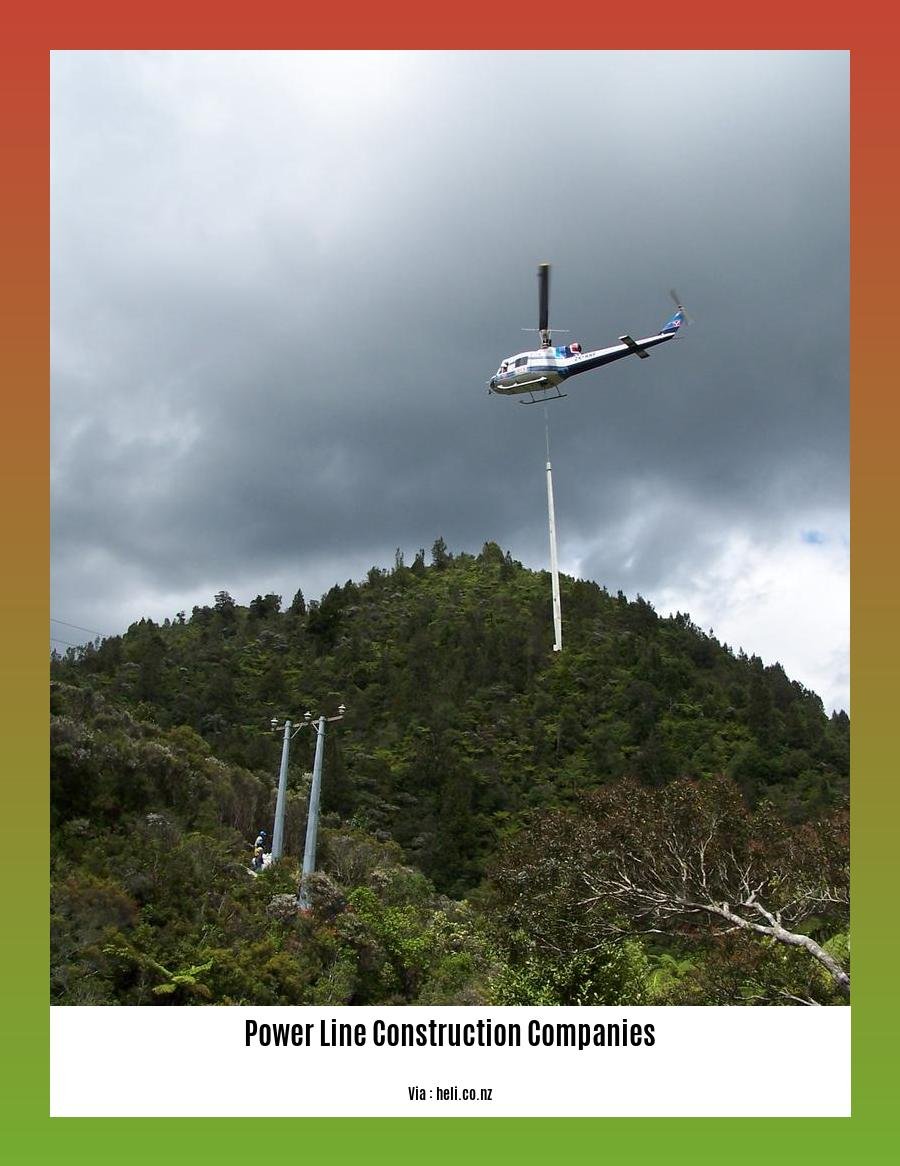Welcome to our comprehensive guide, “Top Power Line Construction Companies: A Comprehensive Guide for Industry Professionals.” This article provides invaluable insights into the leading companies shaping the power line construction landscape.
Key Takeaways:
- Quanta Services is the industry leader with 11,174.80 miles of transmission lines constructed and 281 projects completed.
- MYR Group Inc. has constructed 5,910.50 miles of transmission lines across 141 projects.
- ABB offers power transmission solutions and has completed 59 projects with 3,494.1 miles of transmission lines constructed.
- Kiewit is a major transmission line contractor, responsible for 83 projects and 3,409.30 miles of transmission lines.
- Valard Construction specializes in offshore and remote transmission line construction, completing 37 projects and 2,977.90 miles of transmission lines.
Power Line Construction Companies

Navigating the landscape of power line construction companies requires careful consideration. With a plethora of options available, industry professionals must thoroughly research and select the most suitable partner for their projects. This comprehensive guide will delve into the key factors to consider when choosing a power line construction company.
Expertise and Experience
A power line construction company’s experience is paramount. Look for companies with a proven track record in your specific area of need. Consider their project portfolio, the types of lines they’ve built, and the size and complexity of these projects. Assessing their technical capabilities, such as specialized equipment and certification, is also crucial.
Safety and Compliance
Safety should be a top priority in power line construction. Ensure the company you choose prioritizes safety and adheres to industry standards and regulations. Inquire about their safety protocols, training programs, and incident history. Their commitment to environmental protection and sustainability should also be evaluated.
Financial Stability and Insurance
The financial stability of a power line construction company is essential. Verify their financial performance, bonding capacity, and insurance coverage to ensure they can handle the scale and complexity of your project. Adequate insurance protects both parties in the event of accidents or unforeseen circumstances.
Communication and Collaboration
Effective communication is key for successful project delivery. Choose a company that demonstrates strong communication skills and a collaborative approach. They should be responsive, accessible, and proactive in providing regular updates and addressing concerns.
Cost and Value
While cost is a significant factor, it should not be the sole criterion. Consider the value the company offers in terms of quality, expertise, and long-term partnership potential. Assess their pricing structure, payment terms, and any additional services they provide.
Reputation and References
Industry reputation is a valuable indicator of a power line construction company’s performance. Consult industry professionals, seek references from past clients, and check online reviews to gauge the company’s reliability, customer satisfaction, and reputation.
Table: Top Transmission Line Construction Companies
| Company | Projects | Miles of Transmission Lines |
|---|---|---|
| Quanta Services | 281 | 11,174.80 |
| MYR Group Inc. | 141 | 5,910.50 |
| ABB | 59 | 3,494.10 |
| Kiewit | 83 | 3,409.30 |
| Valard Construction | 37 | 2,977.90 |
For the best and trusted power construction companies, you can visit the link and get your work done.
Do you want to know the best precast building construction companies in India? Here is the link for your work.
This link has the best precast construction companies in India for your need.
The precast construction technology is the latest technology that you can use to construct your building according to your need and get the best result.
If you want to build your dream home with precast house construction in Bangalore, click on the link for the best service.
Technological Advancements in Power Line Construction

Navigating the ever-evolving landscape of power line construction, it’s essential to grasp the latest technological advancements that are reshaping the industry.
Recent innovations are driving greater efficiency, safety, and sustainability in power line projects. From drones to AI-powered tools, these advancements are transforming how we build, maintain, and upgrade power grids.
Benefits and Applications
-
Drones: These unmanned aerial vehicles capture high-resolution imagery for site surveys, line inspections, and asset management, reducing risks and inspection time.
-
Smart Helmets: Equipped with augmented reality, these helmets provide real-time data on construction plans, reducing errors and enhancing worker safety.
-
Mobile-Friendly Construction Software: These tools streamline communication, document management, and project tracking, enabling better collaboration and reduced paperwork.
Enhancing Safety and Efficiency
-
Self-Driving Vehicles: These autonomous vehicles transport materials and equipment, improving safety by reducing the need for human operators in hazardous environments.
-
Advanced Sensors: These devices monitor environmental conditions, power flows, and equipment performance, providing real-time data for optimized grid management and reduced outages.
Key Takeaways:
- Drones, smart helmets, mobile-friendly software, and self-driving vehicles are revolutionizing power line construction.
- Advanced sensors and AI tools enhance safety, efficiency, and grid performance.
- Technological advancements promote sustainability through better planning and maintenance.
Relevant URL Sources:
- 1build: 17 New Technology Advancements Shaking up the Construction Industry
- T&D World: Innovation in Transmission Operation with Advanced Technologies
Best practices for ensuring safety and efficiency in power line construction
As a seasoned energy industry journalist, I’ve seen firsthand the importance of best practices for ensuring safety and efficiency in power line construction. Here’s a closer look at some key considerations:
Planning and Preparation
- Conduct thorough site assessments to identify potential hazards.
- Develop detailed construction plans that outline safety protocols and procedures.
Material Selection
- Use high-quality materials that meet industry standards for strength and durability.
- Choose non-conductive materials for ladders and other equipment to prevent electrocution.
Construction Techniques
- Employ proper grounding techniques to protect workers from electrical hazards.
- Maintain a safe distance from energized lines during all construction activities.
- Use insulated tools and protective gear to minimize the risk of electrical accidents.
Training and Certification
- Ensure that all workers are trained and certified in power line construction safety.
- Provide regular refresher training to keep crews up-to-date on best practices.
Equipment Inspection and Maintenance
- Inspect equipment regularly to ensure it is in good working order.
- Conduct periodic maintenance to prevent breakdowns and accidents.
Emergency Preparedness
- Develop emergency response plans to handle accidents or incidents.
- Provide workers with proper training and equipment for responding to emergencies.
Key Takeaways:
- Prioritize safety throughout the construction process to prevent accidents and injuries.
- Train and certify all workers in power line construction best practices.
- Invest in high-quality materials and equipment to enhance durability and safety.
- Emphasize proper planning and preparation to minimize risks.
- Implement emergency response plans to ensure workers’ safety in case of accidents.
Sources:
- Power Line Safety in Construction
- Power Line Safety: What You Need To Know
Emerging trends and future outlook for the power line construction industry
The power line construction industry is constantly evolving to meet the demands of a changing world. From the rise of renewable energy to the increasing need for grid modernization, there are a number of trends that are shaping the future of this critical sector.
Digitalization and automation
Digitalization is transforming the way that power lines are designed, built, and maintained. From 3D modeling to drones to AI-powered analytics, new technologies are being used to improve efficiency, safety, and reliability.
Growing focus on sustainability
The increasing emphasis on sustainability is driving the development of new power line technologies that minimize environmental impact. These include the use of renewable materials, such as bamboo and jute, and the development of more efficient and environmentally friendly construction methods.
Workforce development
The power line construction industry is facing a shortage of skilled workers. To address this issue, companies are investing in training and development programs to attract and retain new talent.
Key Takeaways:
- Digitalization and automation are transforming the way that power lines are designed, built, and maintained.
- The growing focus on sustainability is driving the development of new power line technologies that minimize environmental impact.
- The power line construction industry is facing a shortage of skilled workers.
Most Relevant URL Sources:
- Emerging Trends in Power Line Construction
- The Future of Power Line Construction
FAQ
Q1: Which companies are leading the power line construction industry?
A1: Quanta Services, MYR Group Inc., ABB, Kiewit, and Valard Construction are among the top transmission line construction companies, with significant project portfolios and miles of transmission lines constructed.
Q2: What are the latest technologies transforming power line construction?
A2: Innovations such as drones, smart helmets, mobile-friendly software, self-driving vehicles, and advanced monitoring systems are revolutionizing the industry, enhancing efficiency, productivity, and safety.
Q3: How can power line construction ensure safety during construction?
A3: Safety measures include using non-conductive materials, carrying ladders horizontally, maintaining a safe distance from power lines, and undergoing specialized training with personal protective equipment (PPE).
Q4: What are the key challenges and opportunities in the power line construction industry?
A4: Balancing sustainability and efficiency while navigating digitalization, addressing economic uncertainty, adapting to cost volatility, and embracing new work and workforce norms are crucial challenges and opportunities facing the industry.
Q5: What companies specialize in offshore and remote transmission line construction?
A5: Valard Construction stands out as a specialist in offshore and remote transmission line construction, undertaking projects in challenging and geographically isolated areas.
- Best Color Backsplash For White Cabinets: Ideas Youll Love - November 27, 2025
- White On White Backsplash: A Timeless Kitchen Design Choice - November 26, 2025
- Tile Backsplash With White Cabinets: A Kitchen Design Guide - November 25, 2025










